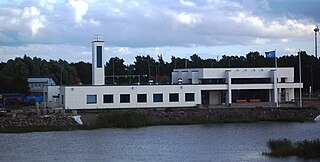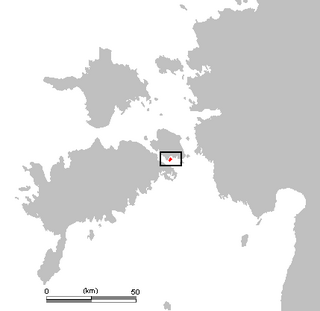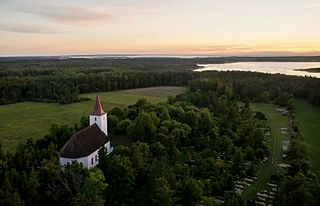
Estonian is a Finnic language of the Uralic family. Estonian is the official language of Estonia. It is written in the Latin script and is the first language of the majority of the country's population; it is also an official language of the European Union. Estonian is spoken natively by about 1.1 million people: 922,000 people in Estonia and 160,000 elsewhere.

In Estonian mythology, Vanatühi is a/the devil or god of the underworld, a giant farmer who is more stupid than malevolent.

Linnusitamaa is a 5.07 ha uninhabited Estonian islet in the Gulf of Riga. It's located about 300 m (980 ft) south of the island of Abruka. Administratively Linnusitamaa belongs to the Abruka village in Saaremaa Parish, Saare County. The island is part of the Abruka Nature Reserve.

West Estonian archipelago is a group of Estonian islands located in the Baltic Sea around Väinameri. The total area is about 4,000 km2 (1,500 sq mi). The archipelago is composed of the islands Saaremaa, Hiiumaa, Muhu, Vormsi and about 900 other smaller islands. The archipelago is separated from the Estonian mainland by the Väinameri Sea.

Virtsu is a small borough in Lääneranna Parish, Pärnu County, Estonia. It lies on the western coast of continental Estonia, and is a location of the main port for traffic to and from Saaremaa, the largest island of Estonia. The Virtsu ferry goes to Kuivastu, which is located on the island of Muhu, which is in turn connected to Saaremaa by the largest causeway in Estonia, the Väinatamm.
Võilaid is a small, uninhabited Estonian island in the Baltic Sea. Its coordinates are 58°30′56″N23°22′12″E.

Suurlaid is a small Estonian island in the Baltic Sea. Its coordinates are 58°31′42″N23°15′39″E

Nootamaa is a small, uninhabited island in the Baltic Sea belonging to the country of Estonia. It marks the westernmost part of Estonia's territorial boundary.

Prangli is an Estonian island in the Gulf of Finland.

Reigi is a village in Hiiumaa Parish, Hiiu County in northwestern Estonia.

Härjakare or Härglaid is a small uninhabited island in Estonia. It lies about 0.5 kilometres (0 mi) west of Käina Bay.
Käkirahu is an island in the Väinameri strait in the southeastern part of Hiiu County, Estonia. The island has a total area of 170 m² with a coastline length of 57 meters.

Liia is an island belonging to the country of Estonia. The island is mostly beach ridges and consists of meadows, juniper and pine forest at its highest points.
Munasaar is a rocky island belonging to the Baltic country of Estonia. Munasaar is located in the Viru-Nigula Parish, which is part of the Lääne-Viru County, one of the 15 counties of Estonia. Seabirds have been reported to frequently nest on the island.
Paelaid is an island belonging to the country of Estonia.
Rusulaid is an Estonian island in the Baltic Sea. This island is referenced a book titled Islands of Estonia.
Uhtju islands is a group of islands belonging to the country of Estonia.

Vaika islands is a group of islands belonging to the country of Estonia. They lie next to Vilsandi. The Vaika islands are referenced in a book titled Islands of Estonia.
Paljarahu is a small island in the Baltic Sea belonging to the country of Estonia.
Estonian women's national under-17 football team represents Estonia in international youth football competitions.
This page is based on this
Wikipedia article Text is available under the
CC BY-SA 4.0 license; additional terms may apply.
Images, videos and audio are available under their respective licenses.












